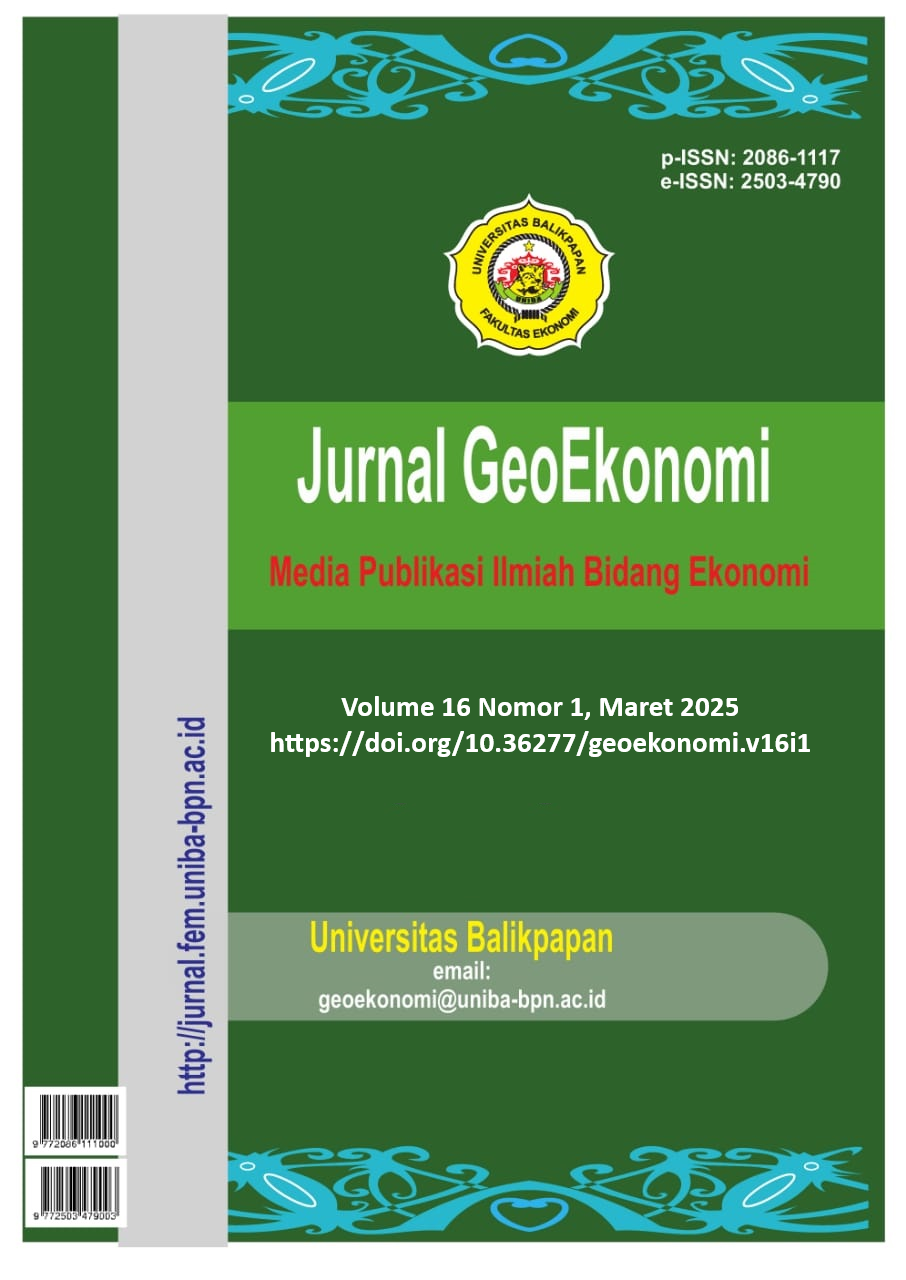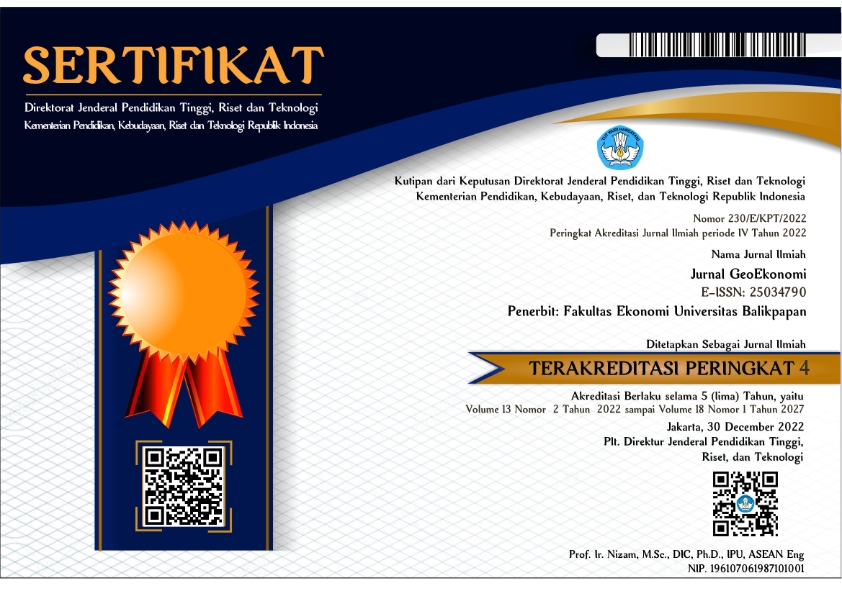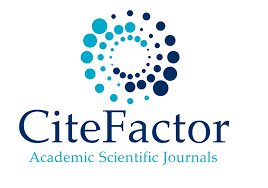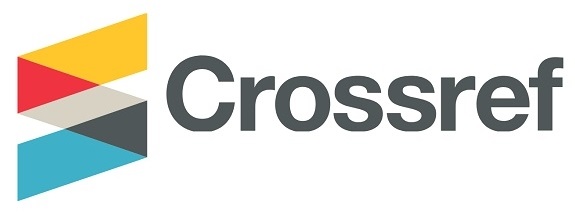PENGARUH LITERASI KEUANGAN DAN PERILAKU KONSUMTIF MELALUI PENGELOLAAN KEUANGAN TERHADAP KEPUTUSAN INVESTASI PADA GENERASI MILENIAL DI KOTA TENGGARONG
DOI:
https://doi.org/10.36277/geoekonomi.v16i1.574Keywords:
Financial Literacy, Consumptive Behavior, Financial Management, Investment DecisionsAbstract
Indonesia is a country with a large population. Experts predict that Indonesia will experience a significant demographic bonus in the coming decades. This is expected to support the achievement of Indonesia's golden era until 2045. The millennial generation is the second largest population group in Indonesia. With the large population of the millennial generation who have entered productive age, they are the main drivers of the country's economic growth. This study was designed to provide an understanding of the influence of financial literacy and consumptive behavior of the millennial generation in Tenggarong City through financial management on their decisions to invest. This study uses an associative quantitative method. This research process obtained 100 people as respondents. Data collection was carried out by distributing questionnaires, which would then be analyzed using an analysis tool in the form of the PLS-SEM statistical technique. The results of this study indicate that investment decisions are significantly influenced by financial literacy and consumptive behavior. Financial management can also be a significant mediator between financial literacy and consumptive behavior on investment decisions. A significant correlation is also found in the relationship between financial literacy and consumptive behavior. Thus, financial literacy and good financial management can help the millennial generation reduce excessive consumer behavior and improve the quality of their investment decisions.
Downloads
References
Alfita, M., Nur Sulistiyowati, L., & Anggraini Setyahety, R. (2023). Simba Seminar Inovasi Manajemen Bisnis dan Akuntansi 5.
Badan Pusat Statistik Kabupaten Kutai Kartanegara. BPS Statistik Kutai Kartanegara. (2024).
BPS. Tingkat Pengangguran Terbuka (TPT). (2022). Diakses dari https://www.bps.go.id/id/pressrelease/2022/05/09/1915/februari-2022-tingkat-pengangguran-terbuka--tpt--sebesar-5-83-persen-dan-rata-rata-upah-buruh-sebesar-2-89-juta-rupiah-per-bulan.html
Brillianti, F., & Kautsar, A. (2020). Apakah Literasi Keuangan Memengaruhi Kesejahteraan Rumah Tangga di Indonesia? Kajian Ekonomi dan Keuangan, 4 (2), 103–115. https://doi.org/10.31685/kek.v4i2.541
IDN Research Institute. Indonesia Millenial Report. (2024). Diakses dari https://cdn.idntimes.com/content-documents/indonesia-millennial-report-2024.pdf
Kementerian Pemuda dan Olahraga. Laporan Kinerja 2022. (2022). Diakses dari https://img-deputi1.kemenpora.go.id/files/document_file/2023/01/25/15/9275lkj-kreativitas-2022.pdf
Latifiana, D. (2017). Studi Literasi Keuangan Pengelola Usaha Kecil Menengah (UKM).
Manajemen, M., & Jambi, U. (2021). Pengaruh Keadaan Demografi Sosial Ekonomi Terhadap Manajemen Keuangan Pribadi Melalui Literasi Keuangan Pegawai BLUD RSUD BAYUNG LENCIR Radius Prawiro. Jurnal Manajemen Terapan dan Keuangan (Mankeu), 10 (01).
Milzam, M., Sigit Taruna, M., & Shofiyuddin, M. (2024). Analisis Keputusan Investasi Gen Z Melalui Literasi Keuangan dan Risk Tolerance. Jurnal GeoEkonomi, 15(1), 14–25. https://doi.org/10.36277/geoekonomi.v15i1.362
Nanda, R. M., Natalia Sudarwati, A., & Ayu Andriani, T. (2024). Pengaruh Media Sosial Terhadap Keputusan Pembelian Melalui Motivasi Konsumen Sebagai Variable Intervening Pada Produk Skincare di Samarinda. Jurnal GeoEkonomi, 15 (1.2024), 201–210. https://doi.org/10.36277/geoekonomi.v15i1.2024.449
Riani, L. P., Sari, N. E., & Wahyuningtyas, E. (2024). City Consequences of Millennials Generation Financial Literacy: A Meta-Analytic Studies. Review Management and Entrepreneurship, 8 (1). https://doi.org/10.21776/ub.jam.2022.021.1.01
Rio, M., Dan, R., & Santoso, B. (2015). Rita dan Santoso: Literasi Keuangan dan Perencanaan Keuangan pada Dana Pendidikan…. Dalam Jurnal Ekonomi: Vol. XX (Nomor 02). http://www.ojk.go.id
Ritakumalasari, N., & Susanti, Ari. (2021). Literasi Keuangan, Gaya Hidup, Locus Of Control, dan Parental Income Terhadap Perilaku Keuangan Mahasiswa.
Sikap, P., Dan, K., Keuangan, P., Keputusan, T., Melalui, I., Keuangan, P. P., Mahasiswa, P., Medan, K., Inovia, N., & Romula Siregar, Q. (2024). Balance: Jurnal Akuntansi dan Manajemen. Dalam Balance: Jurnal Akuntansi dan Manajemen (Vol. 3, Nomor 2).
Stoker, T. M. (1986). Aggregation, Efficiency, and Cross-Section Regression. Econometrica, 54 (1), 171. https://doi.org/10.2307/1914164
Sufyati H. S, & Alvi Lestari. (2022). Pengaruh Literasi Keuangan, Inklusi Keuangan dan Gaya Hidup Terhadap Perilaku Keuangan Pada Generasi Milenial. Jurnal Multidisiplin Madani, 2 (5), 2415–2430. https://doi.org/10.55927/mudima.v2i5.396
Sugiyono. (2022). Metode Penelitian: Kuantitatif, Kualitatif, dan R&D. Alfabeta. 63-65.
World Economic Forum. The Future Of Jobs Report. (2020). Diakses dari https://www.weforum.org/publications/the-future-of-jobs-report-2020
Downloads
Published
How to Cite
Issue
Section
License
Copyright (c) 2025 Dwi Indra Prasetia, Silvana Kardinar Wijayanti, Akhmadiansyah

This work is licensed under a Creative Commons Attribution 4.0 International License.
You are free to:
Share - copy and redistribute the materials in any medium or format for any purpose, even for commercial purposes.
Adapt - compose, change and develop the material for any purpose, even for commercial purposes.
The licensor cannot revoke these freedoms as long as you follow the license terms.
With the following conditions:
Attribution - you must give appropriate credit, provide a link to the license, and indicate if changes have been made. You may do so in a reasonable manner, but not in any way that suggests that the licensor endorses you or your use.
No additional restrictions - You may not implement legal provisions or technological measures that legally restrict others from doing anything permitted by the license.
Notice:
You do not have to comply with the license for elements of the material that are in the public domain or where your use is permitted by an applicable exclusion or restriction.
No warranties are given. This license may not grant all the permissions necessary for your intended use. For example, other rights such as publicity, privacy, or moral rights may limit how you use the material.







_geoekonomi.png)
_geoekonomi.png)
















